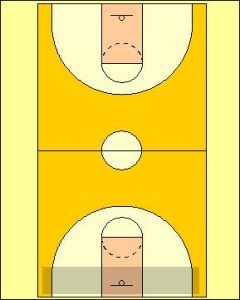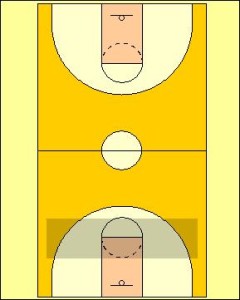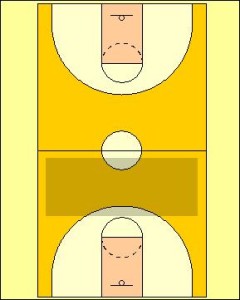Improve your Outlet Zone to Supercharge your Fast Break and Transition
A commonly overlooked facet of a team’s fast break or transition offense often overlooked when considering how to improve performance is the Outlet Zone. The Outlet Zone describes the area in which the ball is passed to for the initial start-up of a fast break or transition phase in basketball. Changing the philosophy of a coach and their team to deepen or push towards the front-court the target Outlet Zone a team looks to utilise, will pay dividends to a team’s overall offense and command over the game.
Understanding the Outlet Zone
Many teams will utilise a set Outlet Zone because of affiliation to a particular system that places players into roles and positions where they are to receive a pass, such as an outlet. Another group of coaches will have not thought about their teams Outlet Zone and so can also benefit from this discussion about the standard areas of out letting of the basketball commonly seen.
Examining a team’s Outlet Zone is very important in developing and understanding of how a team plays basketball. For those teams utilising a shallow Outlet Zone they will have to battle their way through all five defenders. This by its nature takes time and relies often on the full scope of players involved in the offensive play.

The shallowest Outlet Zone can be seen in the shadowed area depicted in the diagram above. An example of this type situation is seen in many games where the rebounder of a missed shot secures possession only to have to wait for a guard or outlet target to come and collect the ball from them. In these situations, the ball is mostly progressed through it being dribbled up the floor. One of the reasons for the offense dribbling out of the back-court is because to pass is difficult with the ball having to progress through the defence instead of around or ahead of it when the outlet is so close to the offensive teams defensive baseline.

The next Outlet Zone (and probably the most common) is for the ball to be outletted to the wing or foul line extended area. Within most systems for transition this is the often depicted starting point for a team’s Primary Transition. This area obviously has some benefits over the previously mentioned shallower area purely because there will be fewer defenders between the ball and the basket. Because of this situation where the ball is outletted ahead of some defenders the changes for a small numbers advantage for the offense can be increased and scoring in broken play can be favourable to the offense in achieving a scoring outcome.

The final depicted Outlet Zone is one which is between the top of the keyway and towards halfway. This Outlet Zone is probably the least common with it only being utilised very rarely within most basketball games. But this does not have to be the standard practice and a team’s Outlet Zone can be changed the same as any team strategy or philosophy.
The benefit of a deeper Outlet Zone are again fewer, if any defenders being between the ball and the basketball. The negative aspect to this strategy are that it sometimes requires a slightly longer outlet pass and passing over or through player traffic which like anything is a skill in itself that must be developed in rebounders especially.
Reasons why you Should Improve your Outlet Zone
While not every team will want to implement a deep Outlet Zone into their team’s offense. What can be analyised is for a team to become more consistent in avoiding the shallowest outlet area. This alone will allow a team who is constantly out-letting in this area to improve their speed and options in moving from one end of the floor to the other.
In fast break and offensive transition the fewer players involved in the play the more likely a succinct scoring option will be found. The more players that are involved in the balls movement from one end of the floor to the other, the harder it is to have every player consistently making the right read at the right time. The deeper the Outlet Zone implemented the fewer players there will be involved in the phase of play. Once also improving a teams commitment to breaking out of their own end of the floor in offense a numbers advantage situation might be more common then not.
By having a deeper Outlet Zone the next pass within a team’s offense will naturally also be further down the floor. This means that in a team’s fast break and transition offense fewer passes will need to be made in advancing the ball from one end of the floor to the other. This again will improve speed and reduce the players needed to effect a positive outcome in attacking the oppositions basket in transition.
Like any outlet situation there are two people involved into the process. The rebounder or player with possession, and the outlet target. It is important that the rebounder is patent and positioned to make a good pass. While the outlet target must be active in finding space and then breaking into the front court while still maintaining control and composure.
By starting to think about a team’s Outlet Zone there is no guarantee that changes need or have to be made. But by thinking about these situations an coach can more easily identify where gaps are and how they can possibly change the teams strategy to achieve a better outcome.







